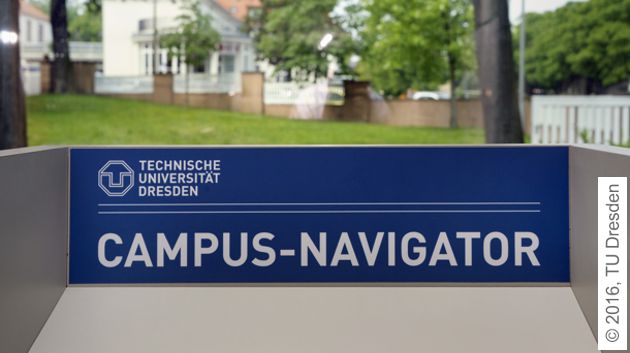Public funded research projects at IAVT/ZmP
Research into fault and failure mechanisms in high-voltage electronic modules
BMBF/BMFTR
- Fraunhofer IPA
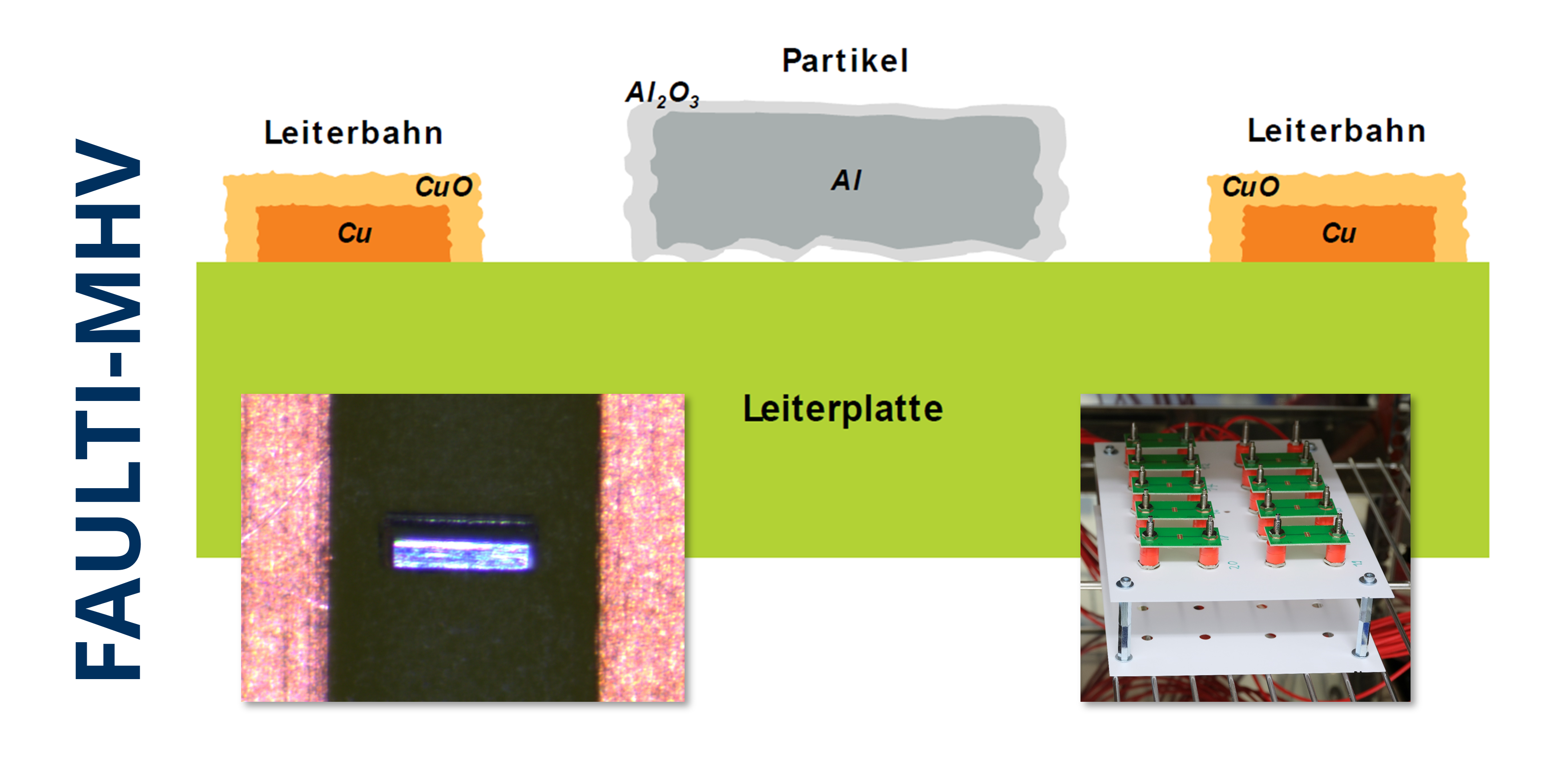
Particle contamination in high-voltage modules for automotive applications poses a functional and safety risk that is currently difficult to assess. DIN EN IEC 60664-1:2022 is frequently applied in the context of insulation coordination, but this standard is limited to contamination of the "micro-environment." It is currently unclear how macroscopic contamination of the module surface or contamination of the macro-environment of the module surface, as addressed in the ZVEI guideline "Technical Cleanliness in Electrical Engineering" and its international counterpart IEC TR 61191-7:2020, should be considered when designing clearances and creepage distances. Furthermore, the risks posed by, for example, textile fibers or plastic particles under the influence of moisture and heat are unknown.
It is also unclear what risks arise from these particles. To answer these questions, the Federal Ministry of Education and Research (BMBF, now BMFTR), with the participation of co-financing industry partners (e.g., Aptiv, BMW, Bosch, Continental), initiated the "FAULTI-MHV" project. The project aims to develop and test various methods and test benches to conduct experiments answering the questions mentioned above.
Zukunftscluster SEMECO (Secure Medical Microsystems and Communications)
BMFTR
- TU Dresden:
- Institute of Semiconductors and Microsystems, IHM (Coordinator)
- Institute of Electronic Packaging Technology, IAVT
- Faculty of Medicine Carl Gustav Carus, Medical Clinic 1
- Ovesco Endoscopy AG
- Renesas Germany GmbH (associated partner)
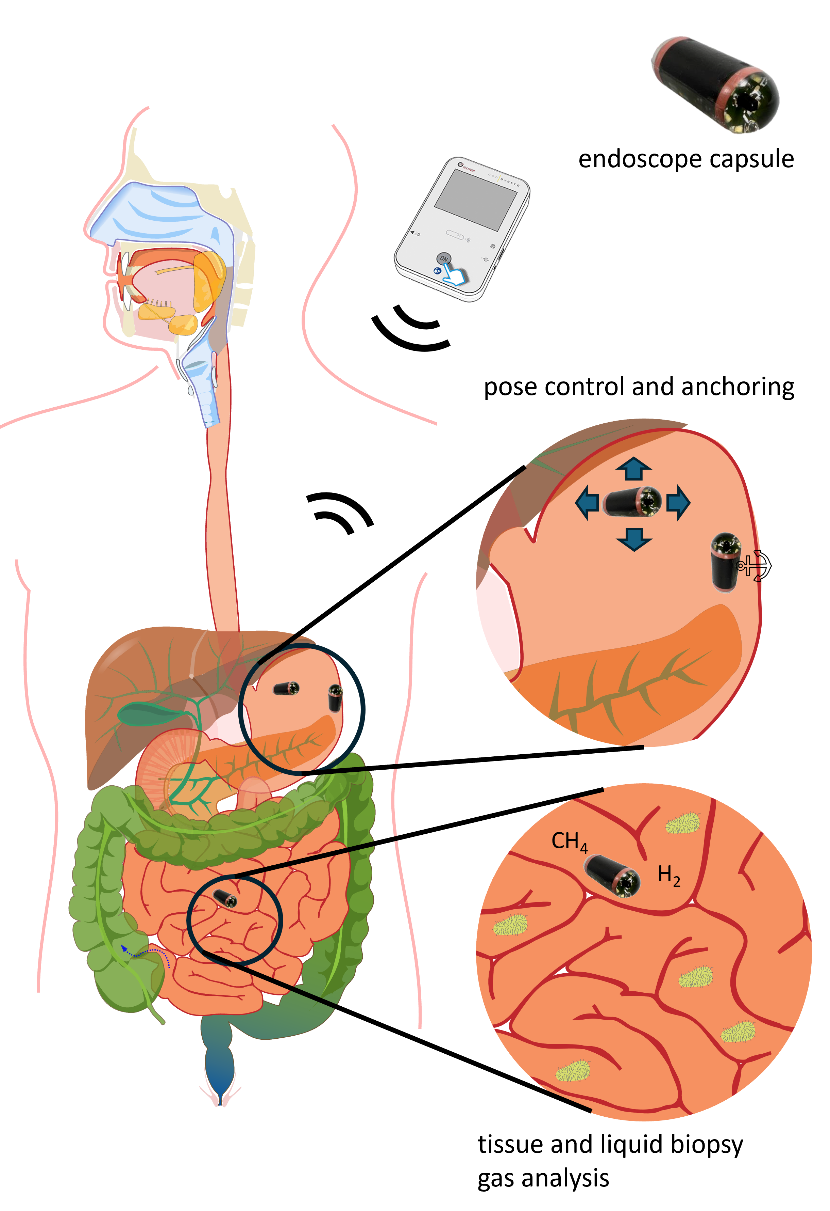
SEMECO-A4, Active intelligent capsule endoscopy
In Germany, around 6 million endoscopies are performed every year. They play a central role in the diagnosis and treatment of cancer and other diseases of the gastrointestinal tract. Capsule endoscopes are an attractive alternative to traditional diagnostic procedures, as they offer a diagnosis of the entire gastrointestinal tract with reduced discomfort or risk of injury for the patient. In addition, regions of the small intestines can be reached that are not accessible by traditional endoscopy. Capsule endoscopes have the potential to significantly reduce the workload of gastroenterologists. Our vision is to develop enhanced functions for capsule endoscopes that include gas sensors and adaptive anchoring mechanisms, the ability to take tissue and liquid biopsies and in vivo microbiome analysis using gas sensors. In addition, secure bidirectional communication through the body at high data rates must be guaranteed. Magnetic capsule pose control will facilitate the precise actuation of the developed mechanisms. Our vision is to develop enhanced functions for capsule endoscopes that include adaptive anchoring mechanisms, the ability to take tissue and liquid biopsies and in vivo microbiome analysis using gas sensors. In addition, secure bidirectional communication through the body at high data rates must be guaranteed. Magnetic capsule pose control will facilitate the precise actuation of the developed mechanisms.

Method for application-oriented evaluation and classification of loads and derived application recommendations for robust electronic components for construction machinery
BMWK
TUD Institute for Mechatronic Mechanical Engineering, Endowed Professorship for Construction Machinery
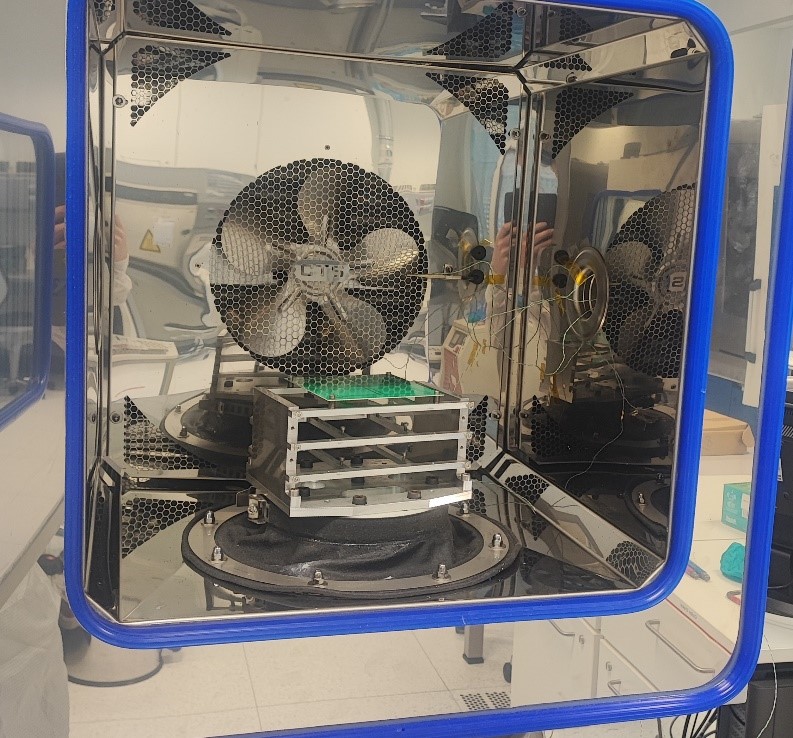
Electrical assemblies are being installed in increasing numbers and with growing integration into construction machinery due to the increasing automation, digitalization, and electrification of construction sites and their equipment. These assemblies, especially in construction machinery and its attachments, are often exposed to severe thermal and mechanical stresses. A significant problem is that many electrical components are not designed or dimensioned for such stresses. Furthermore, no standard for testing electronics in construction site environments exists. This problem leads to the following objectives:
- Recording and evaluating operating loads on construction machinery
- Analyzing complex assemblies in use
- Developing a method for testing electrical assemblies and/or components for use in construction machinery
- Deriving recommendations for the development of electrical assemblies for construction machinery
Extrem Energieeffiziente Edge Cloud Hardware am Beispiel Cloud Radio Access Network
BMBF
- Technische Universität Dresden
- Vodafone Chair of Mobile Communications Systems
- Institute of Electronic Packaging Technology
- Chair of Compiler Construction
- Chair of Circuit Design and Network Theory
- Chair of Radio Frequency and Photonics Engineering
- eesy-IC GmbH Erlangen
- ficonTEC Service GmbH Achim
- viimagic GmbH Dresden
- GCD Printlayout GmbH Erlangen
- Micro Systems Engineering GmbH Berg/Ofr.
- VI-Systems GmbH Berlin
- Associated: GlobalFoundries LLC & Co. KG, Nokia Bell Labs, Vodafone GmbH, Cloud&Heat Technologies GmbH, National Instruments Corp.
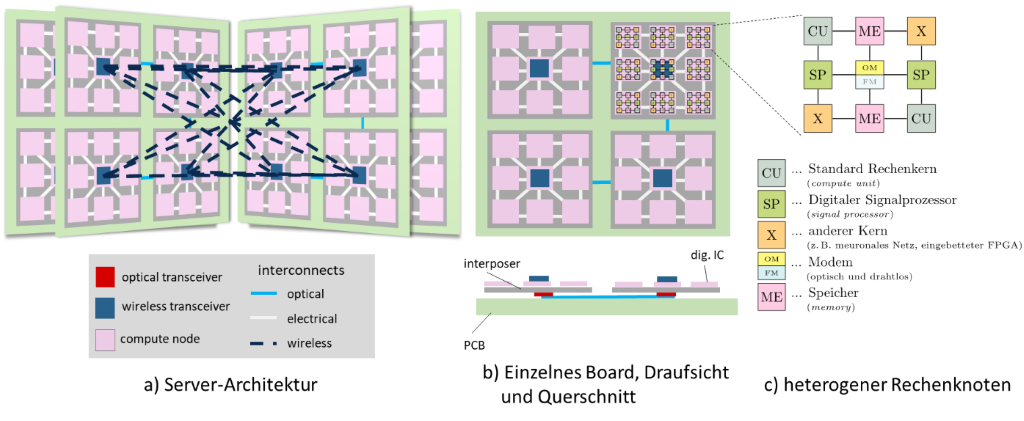
The BMBF project E4C (Extrem Energieeffiziente Edge Cloud Hardware am Beispiel Cloud Radio Access Network) develops an innovative concept for new, scalable computer architecture, which combines the specialized computing nodes and a new data communication structure based on electrical, optical and wireless communication links. This architecture can be implemented into edge-servers in virtualized 5G mobile access networks and can have a capability for energy saving up to 90%. The fabrication of such heterogeneous computing node (see figure) needs a co-integration of chip components on a common interposer substrate. Our institute will in the E4C-project work on packaging approaches for integration and of optical and wireless transceivers (TRx). The DFG CRC 912 HAEC explored on scalable fabrication methods for the integration of optical and mm-wave hardware. Based on this experience, in this project passive components (optical couplers, antennas etc.) will be co-integrated with active ICs into the TRx-packages. The E4C-targeted energy saving will be pursued in the packaging field by using of low-loss and reliable contacts and optimized wiring as well as with application of novel chip integration technologies.
The E4C-project proposes an innovative hardware approach to solve a key problem of 5G-base stations, which in future will bear a significant energy costs for the distribution of computing load in virtualized mobile access networks.
Novel joining techniques for high-performance electronic components
BMBF - KMU-innovativ
IMG Electronic & Power Systems GmbH
budatec GmbH
PFARR Stanztechnik GmbH
G&W Leiterplatten Dresden GmbH & Co. KG
Fraunhofer IKTS, Materialdiagnostik
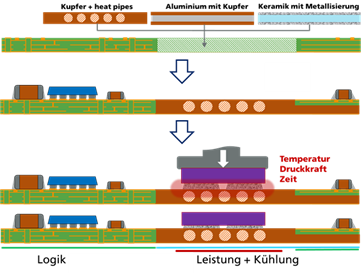
The goal of this project is the first-ever integration of hybrid printed circuit boards with the connection technologies diffusion soldering, sintering and SMT soldering through heterogeneous
integration, in order to enable SMEs to produce highly integrated modules of high-performance electronics from 20 kW upwards. Using the exemplary functional assembly from the application provider IMG (railway electronics, Line 10 Nordhausen, approx. 180 kW), consisting of power electronic inverters and control electronics, the following objectives will be pursued and technologically demonstrated:
- first-time integration of high-current printed circuit boards and selective temperature-resistant joining technology,
- multiple functional elements integrated into the printed circuit board (see heat pipe),
- first-time integrated solution of logic and power sections on a single assembly as a "single-board unit" within power electronics,
- cost reduction in the manufacturing of power electronics, and
- increased power density for power electronics in the range from 20 kW to 200 kW and above through reduced installation space and weight.
Miniaturized, autonomous sensor for condition monitoring
BMWi - IraSME-ZIM-Project
eologix sensor technology GmbH (Austria)
SES-TEC OG (Austria)
FH JOANNEUM GmbH, Institut Electronic Engineering (Austria)
Universität Klagenfurt, Institut für Intelligente Sensorsysteme (Austria)
LFG Oertel e.K. (Germany)
STV Electronic GmbH (Germany)
Technische Universität Berlin, Research Centert Technologies of Microperipherals (Germany)
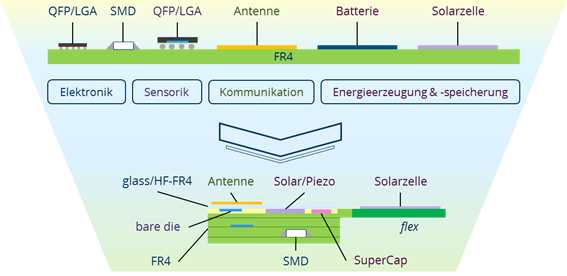
Monitoring efficiency-sensitive and safety-critical systems requires new electronic sensor modules with improved functionality, integrability, reliability, and manufacturability. In a collaborative consortium of Austrian and German R&D partners, module-integrated solutions for energy generation and storage, reliable multilayer flex technologies, digital additive manufacturing processes, and module-integrated antennas will be developed. Integrated into a sensor system, these solutions should offer the following advantages:
- adaptable sensor design to the three-dimensional shapes of the components being monitored, while simultaneously reducing size and weight,
- wireless communication capability,
- energy-autonomous operation, and
- long service life under harsh environmental conditions in application areas such as renewable energy, aerospace, railway technology, robotics, and many more.
Partners from industry and academia will collaborate across borders.
High-performance nano-compounds for microelectronic components
BMBF - KMU-innovativ
NanoWired GmbH
Becker & Müller Schaltungsdruck GmbH
GED Gesellschaft für Elektronik und Design mbH
Huber Automotive AG
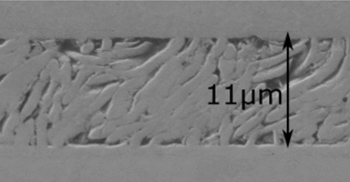
The project aims to develop a new KlettWelding-based assembly and interconnection technology and two electronic demonstrators (high-frequency data logger, high-performance DC/DC converter) based on the new Nano-AVT technology, which will meet the stringent technical requirements of autonomous driving for the first time. Replacing conventional solder joints completely eliminates the need for halogenated fluxes and reduces process temperatures by more than 80%. Furthermore, a new, full-surface, rigid connection based on KlettWelding technology will be developed to replace conventional connectors between printed circuit boards. To enable mass production of both the data logger and the DC/DC converter, a new technical interface for integrating the KlettWelding-based connections into printed circuit board manufacturing will be developed.
6G-life
BMBF
Technische Universität München (TUM)
TU Dresden and the Technical university of Munich have joined forces to form the 6G-life research hub to drive cutting-edge research for future 6G communication networks with a focus on human-machine collaboration. The merger of the two universities of excellence combines their world-leading preliminary work in the field of tactile internet in the Cluster of Excellence CeTI, 5G communication networks, quantum communication, Post Shannon theory, artificial intelligence methods, and flexible hardware and software platforms.
IAVT/ZMP contributes in the application package 3.5 of 6G-life
Adaptive Microelectronics and Network Hardware
AIM:
Multi-functional interaction/cooperation between man and machine in 6G, faster, more flexible and more reliable through adaptive HW / SW
AI human-machine interface, sensor fusion, behavior detection and prediction, adaptive 6G edge nodes
Partners in AP3.5:
Bock TUD, Fettweis TUD, Göhringer TUD, Herkersdorf TUM, Mayr TUD, Steinhorst TUM, Tetzlaff TUD
Work Objectives
- Modeling, analysis, simulation and prototypical realization of newly emerging memory modules for the development of an in-memory computing concept and an adaptive edge-node architecture as the core of the high speed and low latency of AI chips / systems
- Direct integration of structures of a cellular non-linear / neural network (CNN) with haptic sensors and actuators
- Reconfigurable chip-based hardware (low latency and energy consumption) in combination with a flexible software solution
- Reconfigurable hardware Adaptive, energy-efficient, reliable RAN nodes as well as innovative system architecture and methodology for 6G
- Chiplet-based microelectronics will expand the sixth generation (6G) tactile internet with reconfigurable adaptive network nodes and interfaces between technology and the human body
Silicon Photonics for Trusted Electronic Systems
BMBF
Fraunhofer IPMS Dresden
Fraunhofer IZM-ASSID Dresden
Fraunhofer HHI Berlin
OSRAM Opto Semiconductors Regensburg
qutools GmbH München
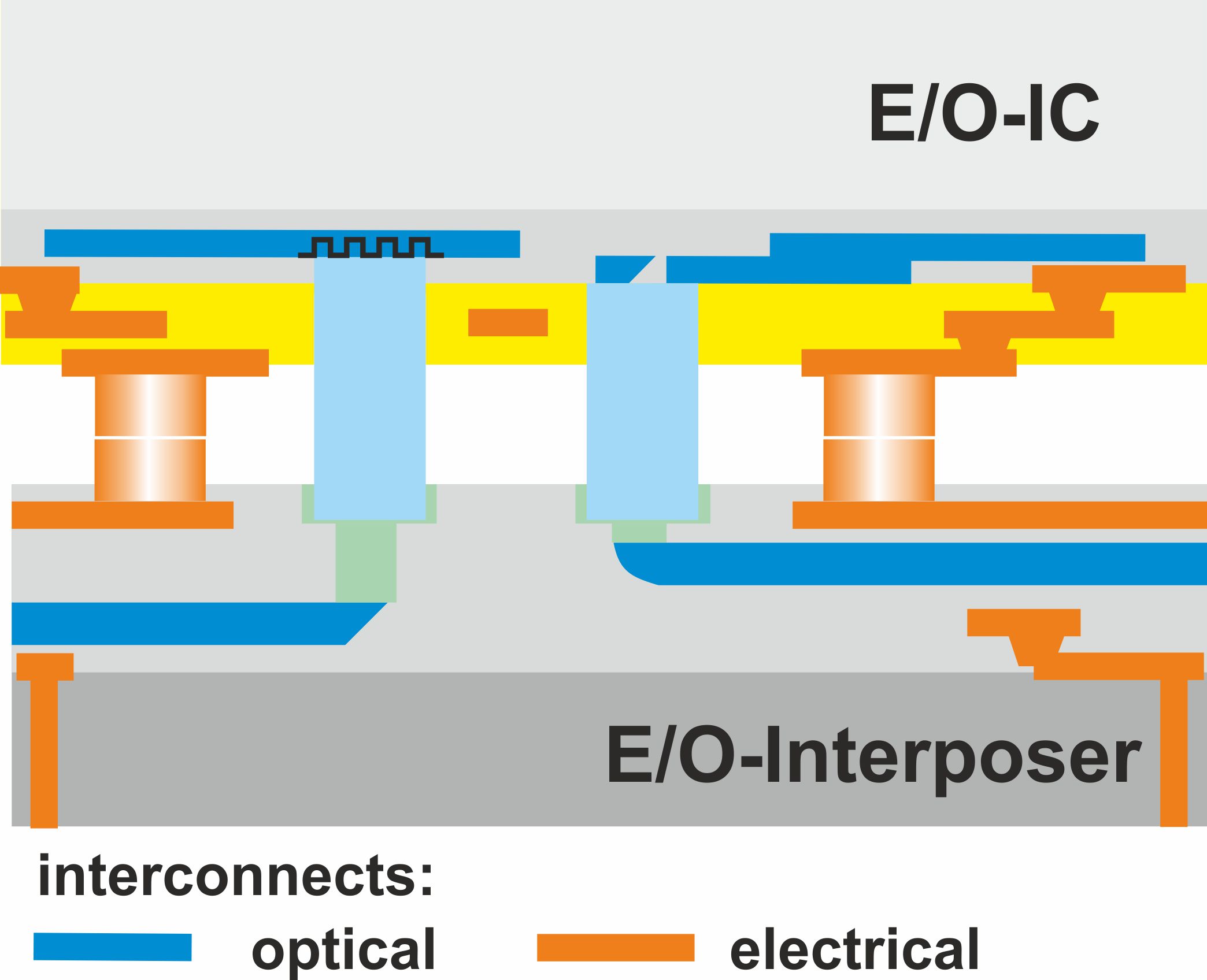
The BMBF project Silhouette (Silicon Photonics for Trusted Electronic Systems) (05/2021-04/2024) develops a platform for design, fabrication and testing of integrated photonic integrated circuits and electro-optical (E/O) interposers for photonic encryption.
With the Silhouette will our IAVT-team research on suitable packaging technologies for scalable and parallel processes of E/O hybrid integration. The focus of the investigations is on the optical signal redistribution on interposer-level and the coupling to chip-level. Direct structurable optical polymers will be used for the integration of optical waveguides and couplers, which enable an efficient and planar coupling into inorganic waveguides on chip-level (SiN-technology). The most modern waveguide materials, 3D printing and substrate processing methods as well as new multi-layer and transfer processes will be used in order to reduce the amount of process steps and thus enhance the yield for fabrication. The goal is to extend the existing technologies for fabrication of electrical interposers with optical wiring in order to integrate the optical functionality. In this regard, the compatibility of the corresponding contacting and assembly processes have to be ensured. Additionally within the Silhouette an automated testing of optical structures on chip- and interposer-level will be developed.
Schwarzer Phosphor in empfindlichen, selektiven und stabilen Sensoren
ForMikro (BMBF)
Helmholtz-Zentrum Dresden-Rossendorf
TU Dresden, Professur für molekulare Funktionsmaterialien
TU Dresden, Institut für Halbleiter- und Mikrosystemtechnik
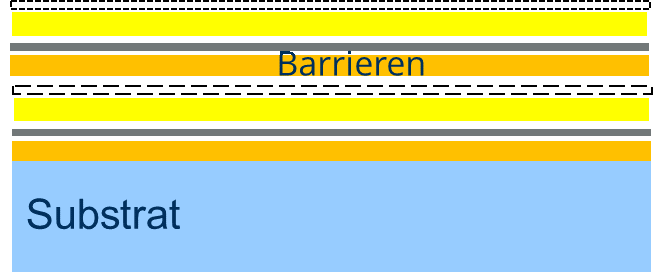
Zweidimensionale (2d) Halbleiter sind dadurch, dass ihre Eigenschaften nahezu ausschließlich durch die Oberfläche dominiert werden, für Anwendungen als Sensoren ausgezeichnet geeignet. Einige 2d-Materialien sind auch unter den Einflüssen von Umgebungsbedingungen stabil. Andere Materialien reagieren sehr stark auf die sie umgebende Atmosphäre und sind dadurch prinzipiell sehr viel empfindlicher bei der Detektion von kleinen Änderungen der Umgebungsbedingungen. Schwarzer Phosphor, ein Halbleitermaterial mit höchster Mobilität bis 200 cm2/Vs, ändert seine Eigenschaften bei Kontakt mit Umgebungsbedingungen sehr stark, so dass die Fabrikation von elektronischen Bauelementen normalerweise unter Schutzgasbedingungen erfolgt. Ziel dieses Projektes ist es, diese Empfindlichkeit des Materials für Anwendungen als Gas- und Biosensoren zu nutzen und dabei eine stabile und selektive Umgebung zu definieren. Besonders die Selektivität ist eine große Herausforderung für Sensoren, die auf 2d-Materialien und insbesondere auf schwarzem Phosphor basieren, weil die hohe Oberflächensensitivität typischerweise nicht selektiv auf die anbindende Spezies reagiert. Diese Selektivität soll durch di, auf spezielle Barrieren basierende, gezielte selektive Durchlässigkeit der Gehäuseumgebung, in die der Sensor eingebettet wird, erreicht werden. In diesem Projekt wird dabei ein spezieller Gassensor basierend auf schwarzem Phosphor als Labormuster erstellt. Die Gehäuseumgebung, die für die Verkapselung der Sensoren entwickelt wird, kann in weiteren Projekten auch als Plattform für eine große Anzahl verschiedener Sensorkonzepte verwendet werden.

Assembly and interconnection technology for optical sensors for use in autonomous driving and Industry 4.0
EFRE / SAB
First Sensor Microelectronic Packaging GmbH Dresden
viimagic GmbH Dresden
MSG Lithoglas GmbH Dresden


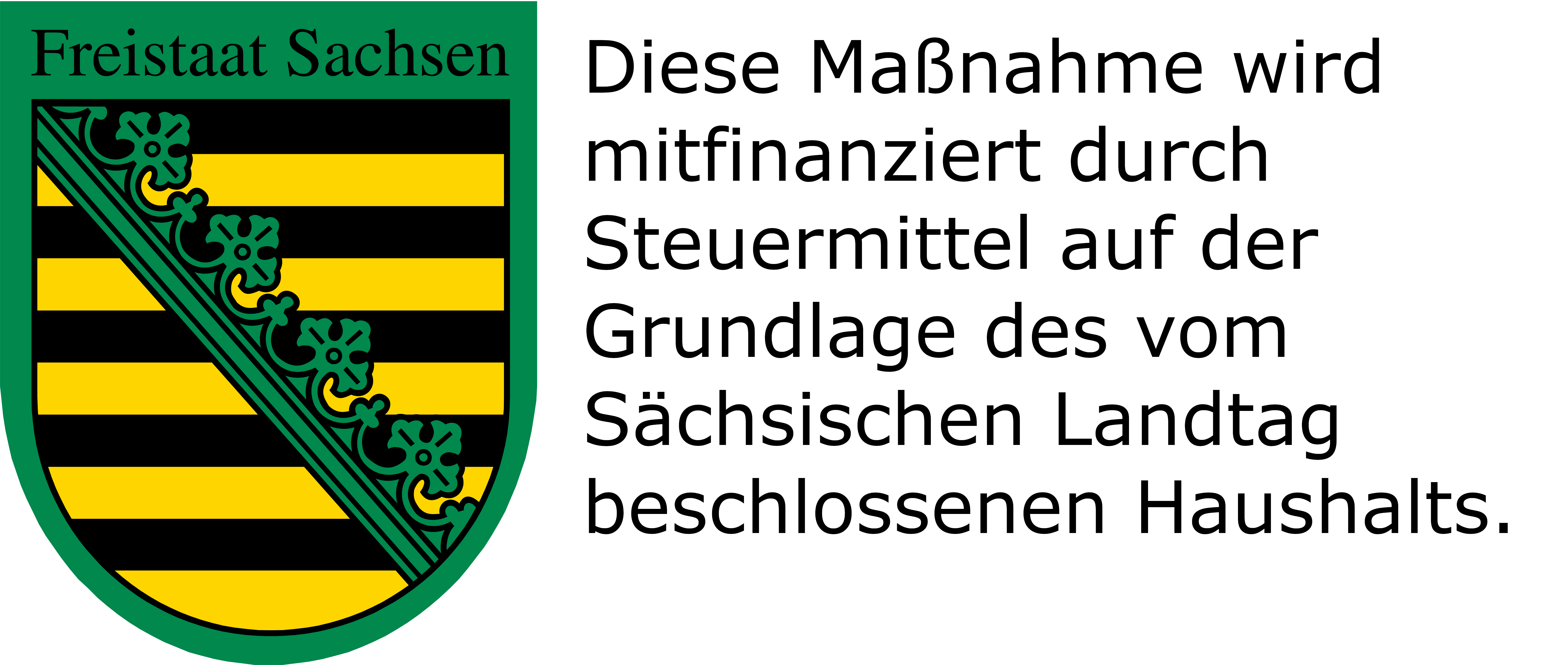
Project goal: Research and development of a new chip-on-board (COB) concept for large image sensors based on laminate substrates in a smaller form factor.
This new technology will enable the direct wafer-level mounting of cover glasses over the sensor area on the sensor chip using adhesive technologies.
A special 3D printing technology will be developed for covering the wire bridges.
Forschungslabor Mikroelektronik Dresden für rekonfigurierbare Elektronik
BMBF
TU Dresden
Das Bundesministerium für Bildung und Forschung fördert auf Basis dieser Förderrichtlinie Investitionen an Hochschulen mit leistungsfähigem Schwerpunkt in der Mikroelektronik.
Durch die Förderung soll die Forschungsausstattung modernisiert und erweitert werden. So sollen neue Forschungsfelder der Mikroelektronik auf internationalem Spitzenniveau erschlossen werden. Zudem soll der wissenschaftliche Austausch und die Kooperation der geförderten Einrichtungen durch eine Vernetzung untereinander als Teil dieser Richtlinie gestärkt werden.
Gefördert werden Investitionen an Hochschulen mit ausgewiesener Expertise im Bereich der Mikroelektronik. Für das IAVT/ZmP wurde das Dickschichtlabor mit einer Schutzgas-Handschuhbox mit einer Sputter- und Bedampfungsanlage sowie einer Atomlagenabscheidung gefördert.
Mechatronics Alliance Saxony – Technology beyond the limits
BMBF
SITEC Industrietechnologie GmbH, Chemnitz
XENON Automatisierungstechnik GmbH, Dresden
Adenso Industrial Services GmbH, Dresden
i2s Intelligente sensorsysteme Dresden GmbH
Kontron AIS GmbH, Dresden
sunfire GmbH, Dresden
Vitesco Technologies GmbH, Limbach-Oberfrohna
Fraunhofer IWS, Dresden
ITW e.V. Chemnitz

AllMeSa's technological leadership enables the realization of systems and products worldwide through end-to-end high-performance manufacturing technologies.
AllMeSa's key technologies, encompassing mechatronic components, assemblies, and processes, participate in the growing mechatronics market (sensors, actuators, electronics).
The AllMeSa partner alliance addresses the progressively increasing complexity of products and technologies and develops the right product from its regional network of expertise.
IAVT Sub-Projects within AllMeSa
IAVT contributes to collaborative projects 3 and 4, thereby supporting the AllMeSa project components in developing novel pressure cell structuring using laser processing and glass sensors for fuel cell or electrolysis stacks.
Within sub-project 4.5, IAVT is developing a pressure/force sensor on ultrathin glass (UTG) with the goal of developing a hybrid technology on ultrathin glass as a key to high-temperature sensing.
Centre for Tactile Internet with Human-in-the-Loop
DFG funded Excellence Cluster
TU München
Deutsches Zentrum für Luft- und Raumfahrt
Fraunhofer-Gesellschaft
Wandelbots
Deutsche Telekom
atlantic labs

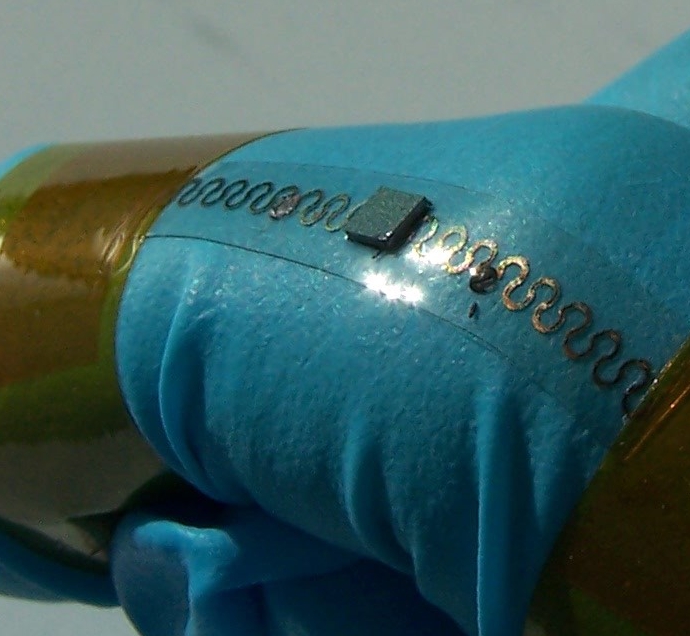
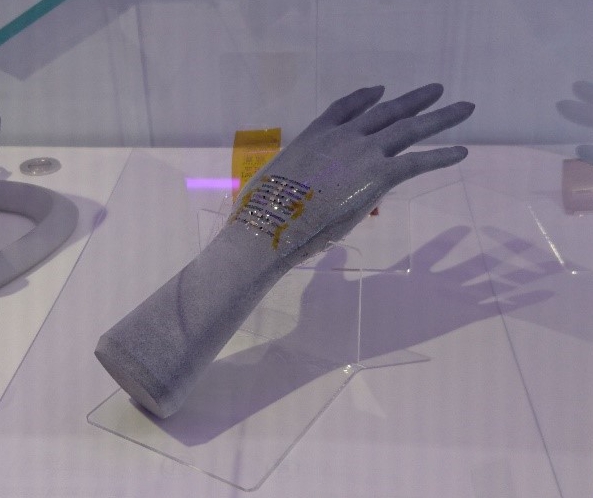
IAVT is part of excellence cluster CeTI
The “Centre for Tactile Internet with Human-in-the-Loop” (CeTI) at TU Dresden will lift the interaction between humans and robots on a new level. In future, people should be able to interact in real time with networked automated systems in the real or virtual world. In particular, humans will be within the feedback loop between the cyber and physical components of technical systems. In order to achieve this goal, various disciplines within the TU Dresden work together on this project, including electrical engineering and information technology, psychology, medicine and neuroscience. Furthermore, external partners including the TU München and the Deutsches Zentrum für Luft- und Raumfahrt and others will support the project.
The IAVT will support this research project with research on reliable flexible and stretchable electronics. The central challenge in CeTI requires sensors, such as touch and positioning sensors, as well as actuators on various positions on the body. The power supply and partially the communication between the individual elements need to be ensured by conductive tracks. Those, on the one hand need to adapt to human movements and shapes through suitable mechanical properties. But, on the on the other hand they need to keep performing flawlessly. In addition, due to the large number of different elements, a high degree of integration and miniaturization is required in order not to influence the motion sequences. Furthermore, very fast processing of the sensor signals and non-delay communication of sensor nodes between human and machine and with the network or edge cloud is required. That leads to a major prerequisite for electronic, which needs to be designed for very high frequencies.
Research group Optical Packaging for 3D-optomechatronic-Devices
DFG
Friedrich-Alexander University Erlangen-Nuremberg (Chair of Factory Automation and Production Systems and Institute of Optics)
Leibniz University Hannover (Institute of Transport and Automation Technology)
Laserzentrum Hannover e.V.
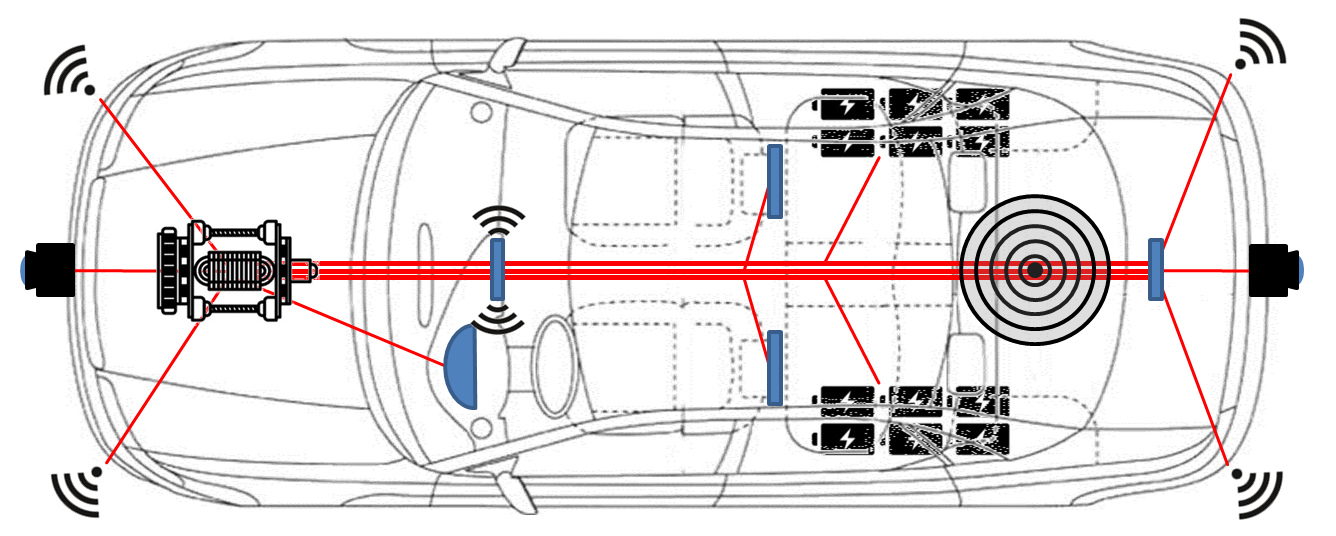
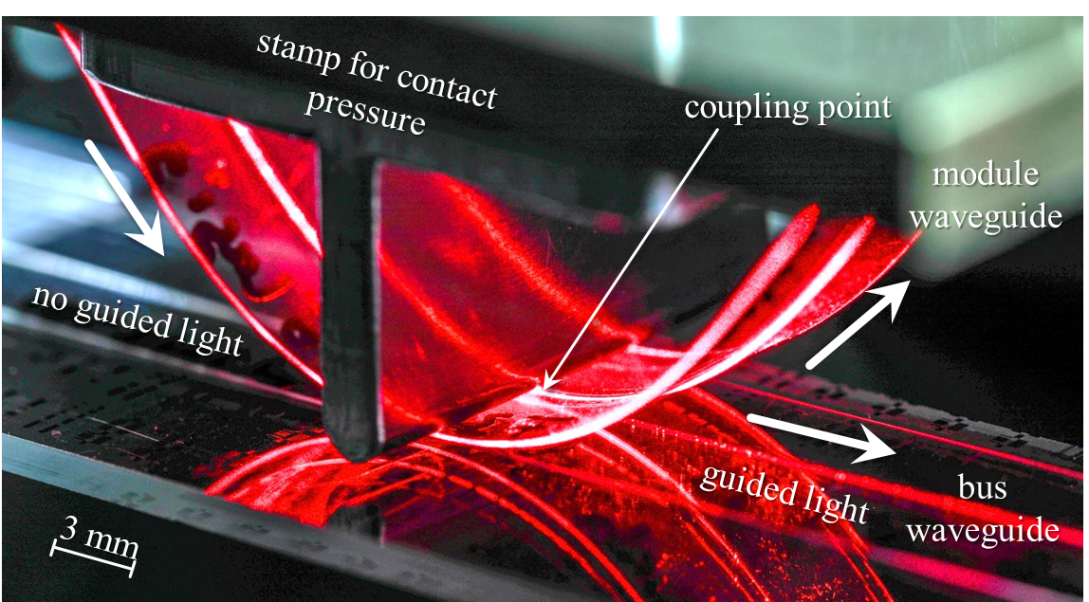
Current roadmaps are increasingly highlighting the role of optical bus systems as the backbone of future sensor and infotainment networks in many areas. Automotive, aerospace and industrial 4.0 applications in particular benefit from high EMC compatibility and low weight. In addition to these advantages, the high bandwidth energy efficiency and the low space requirement of optical connections are especially outstanding. In times of constantly increasing data volumes, standard copper wiring is reaching its limits, especially due to energy consumption at high transmission rates.
In the research group OPTAVER (Optical Packaging for 3D-optomechatronic-Devices) the modelling, simulation and additive production of polymer optical fibers on flexible foil substrates and their connection by asymmetric bus couplers as optical bus systems are investigated. In the first funding period, the system components were realized as planned and demonstrated in cooperation. The optical waveguides were first applied to a two-dimensional foil. This was conditioned in advance to improve the aspect ratio of the waveguide.
In the second funding period, the extension to three-dimensional opto-mechatronically integrated components (3D-opto-MID) is to be investigated. The formability of the thermoplastic film substrates will be used for this purpose. The three-dimensional integration of optical and mechatronic functionalities leads to an increase of the integration density and an extension of the design possibilities of opto-MID. The detachable optical couplers also offer a 3D-capable reconfigurable connection to a bus system.












